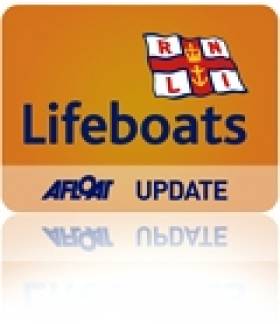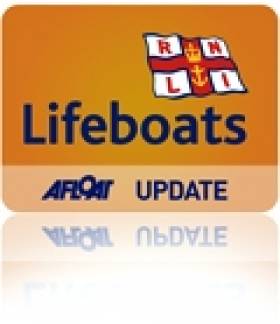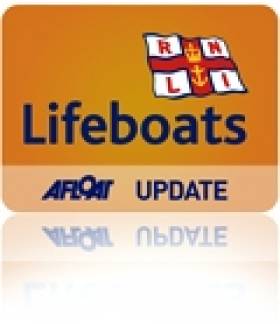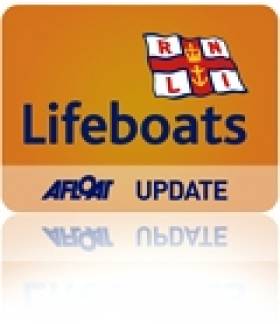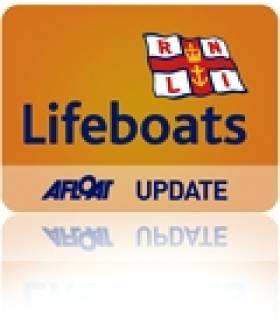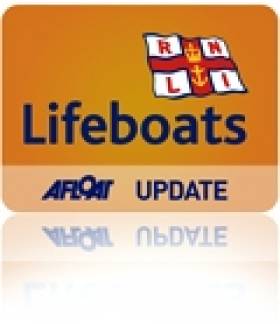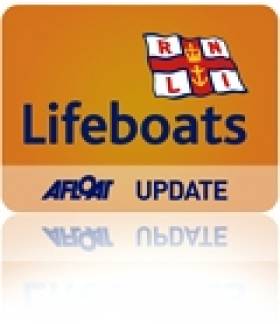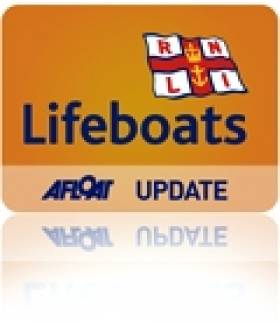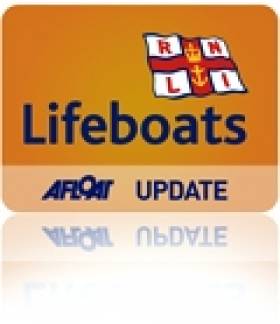Displaying items by tag: Lifeboats
Arklow Lifeboat Rescues Stricken Offshore Powerboat
#RNLI - Following an alert by pager on Sunday 21 September, Arklow RNLI’s lifeboat Ger Tigchlear was launched within minutes to the aid of a powerboat with three persons aboard that was reported to be taking on water.
In calm conditions, the volunteer crew proceeded to scene, and after locating the vessel some two miles south-east of Arklow, a towline was quickly established to get the vessel back to port as quickly as possible.
Upon arrival at Arklow Harbour, where all hands were brought ashore safely, it was decided that due to the level of water that had entered the vessel, the salvage pump needed to be put aboard to enable refloating.
Once the water was cleared, repairs were made and the vessel was refloated and returned to her berth at Arklow Marina.
Speaking following the incident, coxswain Aidan Downey said: “This was a close call. If there had been any delay in alerting the lifeboat, this vessel would have been lost.
"Thankfully we were able to get to the casualty in the nick of time.”
Rosslare Lifeboat Tows Stranded Cruiser To Safety
#RNLI - Rosslare Harbour RNLI towed to safety an 8-metre motor cruiser that was stranded off the Wexford coast with three on board on Thursday evening (18 September).
The volunteer crew launched their all-weather lifeboat at 9pm to go to the assistance of the cruiser, which developed fuel problems some 16 miles north east of Rosslare Harbour.
The three crew on board the cruiser contacted the Irish Coast Guard for assistance. They were in no immediate danger.
Sea conditions were described by the lifeboat coxswain as rough, with a north-easterly wind blowing Force 4-5.
Speaking after the callout, Rosslare Harbour RNLI volunteer lifeboat press officer Jamie Ryan said: "The lifeboat coxswain and crew showed professionalism in establishing a tow in what were described as challenging conditions."
Crosshaven Lifeboat Assists Two Fishermen On Disabled Trawler
#RNLI - Crosshaven RNLI assisted two fishermen yesterday morning (Wednesday 17 September) after their trawler got into difficulty off the Cork coast.
The Cork Harbour volunteer crew was alerted at 11.48am to a report of a fishing vessel with two people on board that was disabled with a line on its propeller.
Launching their inshore lifeboat immediately, the volunteers quickly approached the scene where conditions were blowing an easterly Force 5 wind with a two-metre swell.
The trawler was quickly located near Fish Point and a tow established by the lifeboat crew before the vessel was taken safely to Crosshaven.
Red Bay Lifeboat Rescues Lone Sailor
#RNLI - The volunteer lifeboat crew with Red Bay RNLI in Co Antrim were paged on Friday evening (12 September) at 6.55pm to a lone sailor on a 22ft yacht who got into difficulty in strong tides off the North Antrim coast.
The sailor had left Portrush for Bangor at 7am that morning and requested assistance from Belfast Coastguard later in the day after he was unable to make any headway in the seas.
The lifeboat had difficulty locating the vessel due to fog and the fact that the tides had pushed the boat some four miles off course south of Rathlin Island.
However, once located, the yacht was towed by the Red Bay lifeboat crew to Cushendall, arriving at 9.45pm.
Red Bay RNLI spokesman Paddy McLaughlin commented: "Tonight's call out was made more difficult due to the strong tides and fog but we were able to locate the sailor using our onboard VHF direction-finding equipment and radar."
The volunteer lifeboat crew from Cushendall have been kept busy over the past few months answering a large number of emergency calls off the North Antrim coast.
Isle Of Man Lifeboat Launches To Person In Irish Sea
#RNLI - Lifeboat volunteer crewmembers with Douglas RNLI on the Isle of Man were paged at 9.24pm on Thursday evening (11 September) to a report of a person in the Irish Sea off Victoria Pier.
The all-weather lifeboat Sir William Hillary was launched under the command of coxswain Neal Corran, who proceeded to the seaward side of the Victoria Pier where the person was successfully located.
The casualty was recovered to the lifeboat and taken immediately to the Liner Berth inside the harbour to a waiting ambulance.
The lifeboat then returned to the boathouse to be washed down, re-fuelled and was ready again for service at 10.15pm.
Rosslare Harbour Lifeboat Launched To Stranded Yacht Off North Wexford Coast
#RNLI - Rosslare Harbour RNLI has assisted three crew onboard a 20m yacht which got into difficulty off the north Wexford coast yesterday evening (Thursday 11 September).
The volunteer crew launched their all-weather lifeboat at 5pm to go to the assistance of a 20m sailing ketch yacht which had engine failure, some 30 miles north east of Rosslare Harbour off the Wexford coast.
The three crew on board the yacht were in no immediate danger and contacted the emergency services quickly. Sea conditions were calm with a slight south east breeze.
Once located, the yacht was taken in tow and brought to the safety of Rosslare Europort.
Speaking following the callout, Rosslare Harbour RNLI volunteer lifeboat press officer Jamie Ryan said: "We would like to commend the swift action of the yacht’s crew in contacting the coastguard who in turn alerted the volunteers at Rosslare Harbour RNLI."
Bundoran Lifeboat Launches To 'Red Flare' Sighting
#RNLI - Bundoran RNLI has urged anyone planning on setting off fireworks or anything similar that could be mistaken for a distress flare to inform the coastguard in advance after a false alarm on Saturday night (6 September).
At 10.40pm the Bundoran volunteer lifeboat crew were asked to launch by Malin Head Coast Guard to reports of a red flare being sighted somewhere in Donegal Bay.
A red flare is universally known as a distress signal, and when an emergency call was made by a member of the public from Ballyshannon, the watch officers at Malin Head immediately requested the launch of Bundoran RNLI, as well as tasking the Killybegs coastguard boat.
As the caller was unsure of the precise location of the flare, sighting it somewhere between Ballyshannon and St John’s Point, both boats commenced searches of the area. looking for a vessel that may have signalled an emergency.
As the searches were underway, information was received that fireworks had been set off on the coastline in the bay around the time of the emergency call to 999.
Even though it was determined that this was the most likely cause of the red flare sighting, both boats continued to search the area until the coastguard was satisfied that no vessel was in trouble. Both units were then stood down after one hour.
Speaking on their return to the lifeboat station around midnight, Karol McNern, who helmed the Bundoran lifeboat, said: "Thankfully this was just a false alarm and we are, as always, happy to launch to something that people may be unsure of rather than not be launched at all.
"We would however urge anybody who is planning on setting off fireworks, Chinese lanterns or anything that could be mistaken for a distress flare, near the coast, to please inform the coastguard in advance of the approximate time and location so that search and rescue assets need not be unnecessarily launched."
Skerries Lifeboat Tows Motorboat To Safety Off Lambay
#RNLI - Skerries RNLI towed a motorboat with four people on board to safety on yesterday morning (Sunday 7 September) after they developed electrical problems and were unable to start their engine.
Shortly after 11am, Dublin Coast Guard requested the Skerries RNLI volunteer crew to launch their Atlantic 85 lifeboat Louis Simson after receiving a report from another vessel of a motorboat in difficulty on the eastern side of Lambay Island.
The lifeboat, with Eoin Duff at the helm and crewed by Conor Walsh, Peter Kennedy and Rob Morgan, proceeded directly to the last known position of the craft to begin a search. At the time of the launch there was a Force 3 northeasterly wind with calm seas.
The motorboat was quickly located at anchor close to the island. A tow was established and the boat, with four people on board was brought safely to Rush Harbour.
Speaking after the callout, volunteer lifeboat press officer Gerry Canning said: "Sometimes, no matter how well prepared you are, things can go wrong at sea.
"Thankfully another boat spotted the danger and called the coastguard."
Wicklow Lifeboat Rescues Swimmer Off Brides Head
#RNLI - Wicklow RNLI rescued a male swimmer who got into difficulty yesterday afternoon (Thursday 4 September).
The rescue followed a request from the Irish Coast Guard for the volunteer lifeboat crew to search for a missing swimmer at Silver Strand beach.
The alarm was raised by the swimmer’s wife who was concerned for his safety and by members of the public who heard his call for help.
The all-weather lifeboat had already launched at 2.30pm and was on her way to meet and escort a former visiting lifeboat into the harbour when it was requested.
The lifeboat diverted immediately and proceeded south towards Wicklow Head to begin a search. The inshore lifeboat also launched to assist. Weather conditions and visibility in the area were good at the time.
During the search, a person was spotted in the water about one mile offshore near Brides head.
The all-weather lifeboat, under the command of second coxswain Ciaran Doyle, was quickly alongside the casualty. Crewmember Matt Doyle took him from the water using a scramble net.
First aid was administered to the exhausted man by Carol Flahive as the lifeboat made its way back to Wicklow Harbour.
The lifeboat was met on arrival at the East Pier by a waiting ambulance, where the swimmer was treated by paramedics. He did not need to be hospitalised.
It was quickly established that the man had been swimming off Silver Strand when he was carried quite a distance north with the tide and strong currents, which prevented him getting ashore.
At Wicklow Head, he was swept further out to sea. That's when members of the public on the cliff contacted the coastguard after hearing his call for help.
Speaking after the callout, Wicklow RNLI lifeboat operations manager Des Davitt said: "The swimmer was extremely lucky today to be spotted so quickly by the crew and thankfully a tragic outcome was avoided."
Baltimore Lifeboat Aids Drifting Fishing Boat
#RNLI - Baltimore RNLI launched within minutes of being alerted to a drifting fishing boat off Yokane Point, west of the Stags in West Cork.
The two men on board the 30-foot motorboat had set out for a peaceful day's fishing on a sunny Autumn afternoon when found themselves in trouble after their engine failed to restart.
But within half an hour of calling for assistance, the Baltimore lifeboat was alongside, with crewman Kieran Collins establishing a tow.
The lifeboat then towed the fishing boat to safety, arriving at Baltimore Harbour at 5.50pm. The motorboat was then secured to the pier by 6.05pm.
Half an hour later the lifeboat returned to station and was ready for service again after essential cleaning and maintenance by 7pm.
On board were coxswain Aidan Bushe, mechanic Cathal Cottrell, Brian McSweeney, Sean McCarthy, Kieran Collins, Micheál Cottrell and RNLI staffer Johnny Clooney.


























